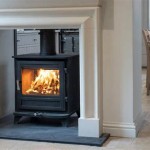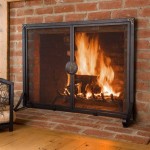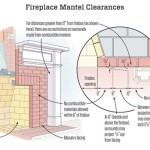Prefab Outdoor Fireplace: The Allure of Wood-Burning Convenience
The allure of a crackling wood fire under a starlit sky is undeniable. For homeowners seeking to bring this rustic charm to their outdoor spaces without the complexities of constructing a traditional masonry fireplace, a prefabricated outdoor wood-burning fireplace presents an attractive solution. These prefabricated units offer a blend of aesthetic appeal, ease of installation, and functional performance, making them a popular choice for enhancing patios, decks, and backyard entertainment areas.
A prefab outdoor fireplace, designed for wood burning, refers to a firebox and chimney system manufactured in a controlled factory setting. These components arrive pre-assembled or in large sections, ready for relatively quick installation compared to building a fireplace from scratch using bricks, stones, or concrete blocks. This prefabrication process ensures consistent quality, precise dimensions, and compliance with safety standards, offering peace of mind to the homeowner.
The growing demand for outdoor living spaces has propelled innovation in the prefab fireplace market. Modern designs cater to a wide range of aesthetic preferences, from rustic and traditional styles that mimic the look of classic stone fireplaces to sleek and contemporary models featuring clean lines and minimalist profiles. Materials used in construction vary, encompassing durable options like powder-coated steel, stainless steel, and reinforced concrete, often combined with decorative stone or brick veneers to achieve the desired visual effect.
Selecting the right prefab outdoor wood-burning fireplace requires careful consideration of several factors, including the size and layout of the outdoor space, local building codes, desired heat output, and aesthetic preferences. Understanding the advantages and limitations of these units is essential for making an informed decision that aligns with individual needs and expectations.
Key Advantages of Prefab Outdoor Wood-Burning Fireplaces
Prefab outdoor wood-burning fireplaces offer numerous benefits that contribute to their increasing popularity among homeowners. These advantages encompass ease of installation, cost-effectiveness, design versatility, and enhanced safety features.
Simplified Installation: One of the primary advantages of prefab fireplaces is their streamlined installation process. Unlike traditional masonry fireplaces that require extensive on-site construction and specialized skills, prefab units are designed for relatively quick assembly. The major components, including the firebox, chimney sections, and optional hearth extensions, are manufactured to precise specifications, facilitating a secure and efficient installation. This simplified installation translates into reduced labor costs and a faster project completion time. Many models come with detailed installation manuals and support resources, enabling experienced DIY enthusiasts to tackle the project themselves, further reducing expenses.
Cost-Effectiveness: The overall cost of installing a prefab outdoor wood-burning fireplace is typically lower compared to building a masonry fireplace from scratch. The prefabrication process reduces labor costs, minimizes material waste, and eliminates the need for specialized masonry skills. While the initial cost of the prefab unit itself might be comparable to the cost of materials for a masonry fireplace, the savings in labor and time often make prefab fireplaces a more financially viable option. Furthermore, the consistent quality and durability of prefab units can translate into lower long-term maintenance costs.
Design Versatility: Prefab outdoor fireplaces are available in a wide array of designs, styles, and finishes, catering to diverse aesthetic preferences and architectural styles. Homeowners can choose from traditional stone or brick veneers that mimic the look of classic masonry fireplaces or opt for modern designs featuring sleek lines and contemporary materials. The availability of various sizes and configurations allows for customization to fit specific outdoor space requirements. Some models offer optional features such as built-in log storage, grilling attachments, and decorative mantels, further enhancing their functionality and visual appeal.
Enhanced Safety Features: Safety is a paramount concern when dealing with open flames, and prefab outdoor wood-burning fireplaces are designed with numerous safety features to minimize risks. These features often include spark arrestors to prevent embers from escaping the chimney, insulated fireboxes to reduce the risk of external surface burns, and integrated air-wash systems to keep the glass door clean for improved visibility and safety. Many prefab fireplaces are rigorously tested and certified to meet stringent safety standards, providing homeowners with peace of mind knowing that their fireplace has been designed and manufactured with safety as a top priority.
Factors to Consider When Choosing a Prefab Outdoor Wood-Burning Fireplace
Selecting the ideal prefab outdoor wood-burning fireplace requires careful assessment of several factors, including space constraints, building codes, heating needs, aesthetic preferences, and maintenance requirements.
Space and Layout: The size and layout of the outdoor space are crucial considerations when choosing a prefab fireplace. Measure the available space carefully to ensure that the fireplace will fit comfortably without obstructing pathways or creating a safety hazard. Consider the proximity of the fireplace to other structures, such as fences, trees, and overhanging roofs, to comply with local building codes and prevent fire hazards. Think about the desired seating arrangement around the fireplace and ensure that there is ample space for comfortable and safe enjoyment of the fire.
Local Building Codes and Regulations: Before purchasing and installing a prefab outdoor fireplace, it is essential to research and comply with local building codes and regulations. These codes often specify minimum clearances from combustible materials, chimney height requirements, and restrictions on open burning. Failure to comply with these regulations can result in fines, delays, or even the removal of the fireplace. Contact the local building department to obtain the necessary permits and ensure that the installation meets all applicable requirements.
Heat Output and Efficiency: The desired heat output is another important factor to consider. The size of the firebox and the efficiency of the combustion system determine the amount of heat that the fireplace will generate. Consider the typical weather conditions in the area and the size of the outdoor space to be heated. For larger spaces or colder climates, a larger fireplace with a higher BTU (British Thermal Unit) rating may be necessary. Look for models with features such as insulated fireboxes and adjustable air controls to maximize heat output and efficiency.
Aesthetic Preferences and Style: The aesthetic appearance of the fireplace should complement the overall style of the outdoor space. Consider the existing architectural features of the house and the landscaping elements in the yard. Choose a design and finish that blends seamlessly with the surroundings and enhances the visual appeal of the outdoor area. Options range from rustic stone veneers to sleek stainless steel finishes, allowing for customization to suit individual tastes.
Maintenance and Durability: The durability and maintenance requirements of the prefab fireplace should also be taken into account. Choose materials that are resistant to weathering, corrosion, and fading. Regular cleaning and inspection are necessary to maintain the fireplace in good working condition. Look for models with features such as removable ash pans and easy-to-clean surfaces for convenient maintenance. Consider the availability of replacement parts and the warranty offered by the manufacturer to ensure long-term satisfaction.
Installation Considerations for Prefab Outdoor Wood-Burning Fireplaces
Proper installation is crucial for ensuring the safety, performance, and longevity of a prefab outdoor wood-burning fireplace. Following the manufacturer's instructions and adhering to local building codes are essential for a successful installation.
Site Preparation: Preparing the installation site is the first step in the installation process. Ensure that the ground is level and stable before setting the fireplace foundation. If installing the fireplace on a deck or patio, verify that the structure can support the weight of the unit. Consider the drainage around the fireplace to prevent water damage. Clear the area of any combustible materials, such as dry leaves, branches, and flammable liquids.
Foundation and Hearth: The fireplace foundation provides a stable base for the unit and helps to distribute the weight evenly. The foundation should be constructed of non-combustible materials, such as concrete or stone. The hearth extends beyond the firebox opening and provides a protective barrier against embers and sparks. The hearth should be sized according to local building codes and the manufacturer's recommendations.
Chimney Assembly: The chimney is a critical component of the fireplace system, as it vents the smoke and combustion gases away from the outdoor space. Assemble the chimney sections according to the manufacturer's instructions, ensuring that each section is securely connected. Use appropriate sealant to prevent leaks. The chimney height should comply with local building codes to ensure proper draft and prevent smoke from entering nearby buildings.
Clearances and Safety: Maintaining proper clearances from combustible materials is essential for preventing fire hazards. Follow the manufacturer's instructions and local building codes to ensure that the fireplace is installed at a safe distance from walls, fences, trees, and overhanging roofs. Install a spark arrestor at the top of the chimney to prevent embers from escaping. Ensure that the area around the fireplace is well-ventilated to prevent the buildup of carbon monoxide.
Professional Installation: While some experienced DIY enthusiasts may be able to install a prefab outdoor wood-burning fireplace themselves, it is often recommended to hire a qualified professional installer. A professional installer has the knowledge, skills, and tools necessary to ensure that the fireplace is installed safely and correctly. A professional installation can also help to prevent potential problems and ensure that the fireplace meets all applicable building codes.

Outdoor Fireplace Kits Stonewood S Cape Cod Ma Nh Ct

Outdoor Fireplaces Round Grove S

Diy Outdoor Fireplace Kit Fremont Makes Hardscaping And Easy

Outdoor Fireplace Kits Prefab Fireplaces Patio Furnishings

Outdoor Fireplace Kits Masonry Stone

Outdoor Fireplace Kits Masonry Industries Inc

Diy Outdoor Fireplace Kit Fremont Makes Hardscaping And Easy

Outdoor Fireplace Kits Masonry Stone

Suoy 58 In Wood Burning Fireplace Steel Outdoor With Chimney Log Holders Tool And Pvc Cover

Outdoor Fireplace Kits Southwest Stone Supply
Related Posts








